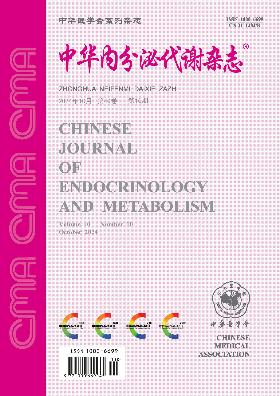Thyrotropin-secreting adenoma in multiple endocrine neoplasia type 1: one case report and literature review
Q4 Medicine
引用次数: 0
Abstract
Objective To improve the understanding of thyrotropin-secreting adenoma in multiple endocrine neoplasia type 1(MEN1) through analyzing the clinical diagnosis and treatment process, as well as outcomes in one case of this disorder. Methods The clinical manifestations, biochemical and hormone levels, imaging presentations, medical and surgical treatments, and post-operational pathologic findings in the process of diagnosis and treatment of a patient with thyrotropin-secreting adenoma in MEN1 were analyzed. The next generation sequencing followed by Sanger method was used for analyzing MEN1 and related genes. The results were evaluated with online PolyPhen2 and PROVEAN for variation hazard. Results One 19-year old male patient was diagnosed with hyperthyroidism due to thyrotoxicosis and high level of thyroid hormones(THs) with measurable TSH(2.78 mIU/L) and negative thyrotropin receptor antibody(TRAb). Meanwhile, primary hyperparathyroidism was suggested by hypercalcemia, hypophosphatemia, and elevated intact parathyroid hormone(PTH) level, all the parameters were returned to normal after surgical resection of the mass which was below the left thyroid lobe indicated by ultrasound and 99mTc scan. Thyrotoxicosis remained in spite of one year treatment with antithyroid drug, thyrotropinoma was then suspected, and subsequent MRI scan found a macroadenoma at right pituitary. TSH and THs returned to normal 1 month after transsphenoidal removal of the adenoma. As expected, immunohistochemical staining revealed TSH positive. In addition, a pancreatic mass was found by both CT and MRI scan, which was considered as a silent neuroendocrine tumor. Gene analysis revealed a missense mutation of MEN1 as c. 415C>T and p. His139Tyr(H139Y), which was predicted highly hazard. Only five cases of thyrotropinoma in MEN1 were previously reported. Conclusion Thyrotropinoma should be cautiously identified from hyperthyroidism to avoid misdiagnosis and mistreatment, and it should keep in mind that thyrotropinoma may be associated with MEN1 though it would be very rare. Key words: Thyrotropinoma; Multiple endocrine neoplasia type 1; Hyperthyroidism; Hyperparathyroidism; MEN1 gene; Silent pancreatic neuroendocrine tumor多发性内分泌肿瘤1型促甲状腺激素腺瘤1例报告及文献复习
目的通过分析1例多发性内分泌肿瘤1型(MEN1)的临床诊断、治疗过程及疗效,提高对该病的认识。方法对1例MEN1型促甲状腺激素分泌腺瘤的临床表现、生化及激素水平、影像学表现、内科及外科治疗、术后病理结果进行分析。采用下一代测序后的Sanger方法对MEN1及相关基因进行分析。使用在线PolyPhen2和PROVEAN对结果进行变异危害评估。结果1例19岁男性患者因甲状腺毒症和甲状腺激素(THs)水平高而被诊断为甲状腺功能亢进,TSH(2.78mIU/L)可测,促甲状腺激素受体抗体(TRAb)阴性。同时,高钙血症、低磷血症和完整甲状旁腺激素(PTH)水平升高提示原发性甲状旁腺功能亢进,超声和99mTc扫描显示左甲状腺叶以下肿块经手术切除后,所有参数均恢复正常。尽管使用抗甲状腺药物治疗了一年,但甲状腺毒性仍然存在,随后怀疑是促甲状腺激素瘤,随后的MRI扫描发现右垂体有一个巨大腺瘤。经蝶窦切除腺瘤1个月后TSH和THs恢复正常。不出所料,免疫组化染色显示TSH阳性。此外,CT和MRI扫描均发现胰腺肿块,被认为是一种无声的神经内分泌肿瘤。基因分析显示MEN1的一个错义突变为c.415C>T和p.His139Tyr(H139Y),这被预测为高度危险。此前仅报道了5例MEN1中的促甲状腺激素瘤。结论应谨慎地将促甲状腺细胞瘤与甲状腺功能亢进症鉴别,以避免误诊和误治,并应记住促甲状腺细胞癌可能与MEN1有关,尽管这种情况非常罕见。关键词:促甲状腺细胞瘤;多发性内分泌肿瘤1型;甲状腺功能亢进;甲状旁腺功能亢进症;MEN1基因;无症状胰腺神经内分泌肿瘤
本文章由计算机程序翻译,如有差异,请以英文原文为准。
求助全文
约1分钟内获得全文
求助全文
来源期刊

中华内分泌代谢杂志
Medicine-Endocrinology, Diabetes and Metabolism
CiteScore
0.60
自引率
0.00%
发文量
7243
期刊介绍:
The Chinese Journal of Endocrinology and Metabolism was founded in July 1985. It is a senior academic journal in the field of endocrinology and metabolism sponsored by the Chinese Medical Association. The journal aims to be the "Chinese broadcaster of new knowledge on endocrinology and metabolism worldwide". It reports leading scientific research results and clinical diagnosis and treatment experience in endocrinology and metabolism and related fields, as well as basic theoretical research that has a guiding role in endocrinology and metabolism clinics and is closely integrated with clinics. The journal is a core journal of Chinese science and technology (a statistical source journal of Chinese science and technology papers), and is included in Chinese and foreign statistical source journal databases such as the Chinese Science and Technology Papers and Citation Database, Chemical Abstracts, and Scopus.
 求助内容:
求助内容: 应助结果提醒方式:
应助结果提醒方式:


